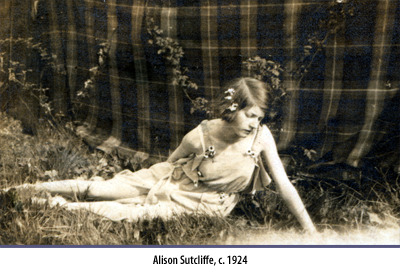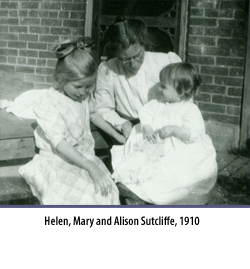| |||||||
![]()
Alison Sutcliffe was born in Toronto in 1909 and grew up in the posh neighbourhood of Parkdale on Toronto's west side. Tree-lined streets framed the rows of grand Victorian houses and ample backyards of lush green grass provided the perfect backdrop for summer afternoons spent playing, and later dancing, outside. Parkdale, which incorporated as a village in 1878, had been annexed by the City of Toronto twenty years before Sutcliffe was born. This neighbourhood became home to a major summer attraction when the Sunnyside Amusement Park and Bathing Pavilion opened on the shore of Lake Ontario; Sutcliffe was thirteen years old. Torontonians flocked to the beach at Sunnyside Park where they could swim, go on rides, play games, stroll along the boardwalk or attend vaudeville shows.

Her artistic bent made Sutcliffe a standout in her family. Her maternal grandfather, George Marter, was a member of the Conservative party and an Ontario MPP in the late nineteenth century when the Conservatives held the opposition. Her immediate family consisted of an established group of chartered accountants beginning with her father, John Ingham Sutcliffe (1861-1941), who was a Fellow of the Institute of Chartered Accountants of Ontario and was also a busy participant in civic matters, for example, he helped the Big Brother Movement obtain a charter and he was also director of the Sportsmen's Patriotic Association, which did charitable work. He married Mary Maud Marter (1870-1952) in 1900 and they had four children: Helen (1902-1995), Ingham (1905-1988), George (1907-1921) and Alison (1909-). Sutcliffe's sister was the first female chartered accountant in Ontario, her brother Ingham was an accountant and her brother-in-law, Tom Burpee, was also a CA.
 Sometime before her brother George's death in 1921 (he was hit by a car), Sutcliffe's parents had separated and she continued to live with her mother at 34 Tyndall Avenue in the older and more affluent area of South Parkdale. Despite the well-heeled address, the family suffered from financial trouble. Sutcliffe's ability to perform and teach would certainly have helped with the family finances; however, it is unknown what she may have contributed monetarily while she lived with her mother. Certainly a woman earning her own money in the 1920s and 1930s would have afforded Sutcliffe freedoms not common to other women of the time, for example, her ability to travel overseas for dance training. Her introduction to the terpsichorean arts came in the form of Scottish Highland dance taught by a woman down the street from her Tyndall Avenue home, but more serious studies soon followed with Mildred Marsh at the Margaret Eaton School of Literature and Expression on McGill Street. (next page)
Sometime before her brother George's death in 1921 (he was hit by a car), Sutcliffe's parents had separated and she continued to live with her mother at 34 Tyndall Avenue in the older and more affluent area of South Parkdale. Despite the well-heeled address, the family suffered from financial trouble. Sutcliffe's ability to perform and teach would certainly have helped with the family finances; however, it is unknown what she may have contributed monetarily while she lived with her mother. Certainly a woman earning her own money in the 1920s and 1930s would have afforded Sutcliffe freedoms not common to other women of the time, for example, her ability to travel overseas for dance training. Her introduction to the terpsichorean arts came in the form of Scottish Highland dance taught by a woman down the street from her Tyndall Avenue home, but more serious studies soon followed with Mildred Marsh at the Margaret Eaton School of Literature and Expression on McGill Street. (next page)
![]()
©2008, Dance Collection Danse
Alison Sutfcliffe Exhibition Curator: Amy Bowring
Web Design: Believe It Design Works
Family Photos



